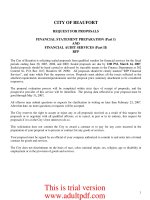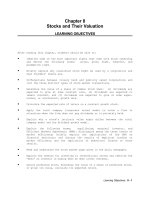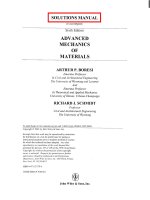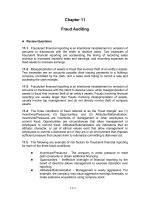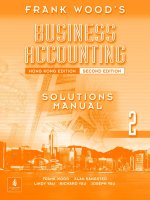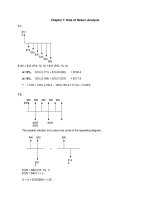Chapter 11 solutions 5th edition - Solution manual of Business Analysis & Valuation Using financial statement.
Bạn đang xem bản rút gọn của tài liệu. Xem và tải ngay bản đầy đủ của tài liệu tại đây (174.84 KB, 7 trang )
Chapter 11
Chapter 11
Mergers and Acquisitions
Discussion Questions
1. Since the year 2000, there has been a noticeable increase in mergers and acquisitions among firms in
different countries (termed cross-border acquisitions). What factors could explain this increase? What
special issues can arise in executing a cross-border acquisition and in ultimately meeting one’s objectives
for a successful combination?
Several factors could help explain the increase in merger and acquisition activity between firms in
different countries. These factors may include:
Relaxation of foreign ownership laws. As countries have allowed greater foreign ownership of
companies in certain industries (e.g., broadcasting, telephone, steel, automobile), foreign companies
have undertaken mergers that were previously prevented due to governmental restrictions.
Expansion of regional free trade areas. Once a regional trading block is implemented, it can
become more difficult for foreign firms to export its products to countries within the block. As a
result, a foreign firm may purchase a company within the block to guarantee access to the block.
For example, many American firms rushed to purchase European firms before January 1, 1996 to
assure continued access to markets of European Union members as integration of the EU markets
entered its next phase. Similarly, increased free trade can create new opportunities for firms within
the block to expand their markets. Acquisitions can provide a way of taking advantage of these
opportunities. For example, the integration of markets in Europe may provide opportunities for, say,
German and U.K. banks to use cross-border acquisitions to develop into a European bank.
Globalization of certain industries. Once a company has reached the maximum production in its
home market, it may seek greater economies of scale and scope by purchasing competitors in
foreign markets. By expanding its production to the greatest extent possible, the firm hopes to
achieve the most efficient cost structure. This globalization forces the remaining companies to
consolidate to achieve the same level of scale and scope economies.
Search for new markets. Once domestic markets for a specific product have matured, a domestic
firm will often try to continue its expansion in foreign markets. Often, the easiest way to enter a
foreign market is to purchase a company already operating in that market. It guarantees immediate
market share and instant name recognition with local consumers.
International mergers will create special issues that will ultimately affect the success of the merger.
These special issues may include valuing a foreign company that operates and prepares its financial
reports under different accounting rules. Differences in accounting rules may include:
© 2013 Cengage Learning. All Rights Reserved. May not be scanned, copied or duplicated, or posted to a publicly accessible website,
in whole or in part.
2 Instructor’s Manual
•
Treatment of intangibles, such as research and development expenses, brand names, goodwill,
patents, etc.
•
Treatment of inflation.
•
Foreign exchange exposure.
•
Hedging acquisition price.
•
Hedging future cash flows from the foreign firm.
•
Regulatory considerations.
•
Foreign government investment approvals.
•
Foreign government antitrust approvals.
•
Ability to expatriate earnings from the foreign country.
•
Differences in laws, regulations, and rules governing personnel and human resources areas.
•
Differences in the operations of foreign markets and companies, including differences in
management practices, worker norms and expectations, roles of government in the economy,
and corruption in the business and political environments of the economy.
•
Management and coordination of domestic and foreign operations.
2. Private equity firms have become an important player in the acquisition market. These private
investment groups offer to buy a target firm, often with the cooperation of management, and then take the
firm private. Private equity buyouts rose from just 2 percent of U.S. merger and acquisition activity in
2000 to 15 percent as of December 2005. Private equity buyers tend to finance a significant portion of the
acquisition with debt.
a. What types of firms would make ideal candidates for a private equity buyout? Why?
b. How might the buyout firm add sufficient value to the target to justify a high buyout premium?
a. Ideal private equity firms are those that
•
Generate relatively stable cash flows to repay the debt used to fund the private equity
acquisition.
•
Have relatively low tax shields prior to the buyout, so that the acquisition can create new value
through interest tax shields.
•
Have assets in place, versus growth options or intangible assets. If acquired firms have high
growth opportunities, any financial distress due to high leverage will probably reduce their
ability to fund the new opportunities. Acquired firms with intangible assets (such as star
research personnel) will also be affected by financial distress since these highly valued assets
can leave, whereas assets in place cannot.
b. The acquirer might provide opportunities for better management of the firm’s operations. The
buyout debt imposes fiscal discipline on a firm’s managers and employees. The firm is required
to make large debt payments on a regular basis; otherwise the firm could be in default and taken
over by its creditors. Management and employees alike would probably lose their jobs. In order
© 2013 Cengage Learning. All Rights Reserved. May not be scanned, copied or duplicated, or posted to a publicly accessible website,
in whole or in part.
Chapter 11 Mergers and Acquisitions 3
to make debt payments, management and employees are forced to eliminate any wasted
expenditures, reduce the firm’s cost structure, and increase the firm’s efficiency.
3. Kim Silverman, CFO of the First Public Bank Company, notes: “We are fortunate to have a cost of
capital of only 7 percent. We want to leverage this advantage by acquiring other banks that have a higher
cost of funds. I believe that we can add significant value to these banks by using our lower cost
financing.” Do you agree with Silverman’s analysis? Why or why not?
Disagree. In general, a company’s cost of capital is related to the riskiness of its underlying assets.
As long as the risk of the assets does not change, then the cost of capital related to those assets will
remain the same, regardless of who owns the assets. If a firm with a low cost of capital buys a firm
with a higher cost of capital, the purchasing firm’s cost of capital will increase accordingly.
One exception, however, is if there are capital market imperfections that make external financing
more expensive. These imperfections could arise from information asymmetries between managers
and outside investors. This type of information problem is likely to occur for newly formed, highgrowth companies. The rapid changes in the business and growth prospects of these firms are often
difficult to communicate adequately to outside investors. Because outside investors have incomplete
information about the company, they require additional compensation, increasing the cost of capital.
It is unlikely that the First Public Bank Company will be able to find any other banks with a higher
cost of capital, due to capital market imperfections. Banks are not typically newly formed, highgrowth companies. The banking industry in the U.S. is a relatively stable and mature industry. As a
result, banks are unlikely to have the types of information asymmetries that are associated with
capital market imperfections. Banks will have higher capital costs due to riskier assets rather than to
information asymmetries. Unless the First Public Bank Company changes the risk of the portfolio of
assets held by a bank it purchases, the other bank’s cost of capital will not change. Consequently,
First Public Bank Company will not be able to take advantage of its lower cost of capital to generate
value by merging with a bank with a higher cost of capital.
4. The Boston Tea Company plans to acquire Hi Flavor Soda Co. for $60 per share, a 50 percent
premium over current market price. John E. Grey, the CFO of Boston Tea, argues that this valuation can
easily be justified, using a price-earnings analysis. “Boston Tea has a price-earnings ratio of 15, and we
expect that we will be able to generate long-term earnings for Hi Flavor Soda of $5 per share. This
implies that Hi Flavor is worth $75 to us, well above our $60 offer price.” Do you agree with this
analysis? What are Grey’s key assumptions?
Disagree. Grey has made two key assumptions, each of which is questionable and could lead to the
Boston Tea Company paying too much for Hi Flavor. First, he assumes that Hi Flavor will have
long-term earnings of $5 per share beginning almost immediately after purchase. It may take several
years for Hi Flavor’s earnings to reach $5 per share once changes in management and operations
have been put into place. If earnings of $5 per share are not immediately attainable, Grey will have
to adjust the expected earnings downward. Otherwise, using $5 per share with the given P/E
multiple will generate a price for Hi Flavor that is too high.
© 2013 Cengage Learning. All Rights Reserved. May not be scanned, copied or duplicated, or posted to a publicly accessible website,
in whole or in part.
4 Instructor’s Manual
Second, Grey assumes that the market will value earnings from Hi Flavor using the Boston Tea
Company’s P/E multiple. Just because the Boston Tea Company owns Hi Flavor does not mean that
the two companies will have the same earnings multiples. Firms are likely to have the same P/E
multiple if their growth and risk characteristics are similar, but Grey has not given us any reasons to
expect that this is the case for High Flavor and the Boston Tea Company. Instead of using the
Boston Tea Company’s P/E multiple, Grey should have used a multiple based on that of firms
similar to Hi Flavor to obtain a more accurate value for Hi Flavor. Hence, Grey’s estimation of Hi
Flavor’s value is likely to be wrong, and a successful bid for Hi Flavor using his valuation could
cause the Boston Tea Company to overpay.
5. You have been hired by GT Investment Bank to work in the merger department. The analysis required
for all potential acquisitions includes an examination of the target for any off-balance-sheet assets or
liabilities that have to be factored into the valuation. Prepare a checklist for your examination.
Off-Balance-Sheet Liabilities
•
Executory contracts
•
Contingent obligations
•
Operating leases
•
Liabilities under environmental regulations
Off-Balance-Sheet Assets
Depending on the specific circumstance, these assets may already be included on the balance sheet.
These assets are either valued (e.g., intangible assets) or revalued (e.g., land held for sale) once they
have been purchased by another company.
•
Research and development expenditures
•
Patents, trademarks, and other intellectual property
•
Brand names
•
Goodwill
•
Land held for sale
6. A target company is currently valued at $50 in the market. A potential acquirer believes that it can add
value in two ways: $15 of value can be added through better working capital management, and an
additional $10 of value can be generated by making available a unique technology to expand the target’s
new product offerings. In a competitive bidding contest, how much of this additional value will the
acquirer have to pay out to the target’s shareholders to emerge as the winner?
There are two sources of value in Firm A’s bid for Company T. One source of value is $15 per share
due to improved working capital management. Firm A, however, is not the only firm that can make
the necessary management changes to generate this value. Any new owners of Company T could
generate $15 in value through better working capital management. Hence, Firm T is worth $65 per
share in the hands of any outside management that can make the necessary changes to working
© 2013 Cengage Learning. All Rights Reserved. May not be scanned, copied or duplicated, or posted to a publicly accessible website,
in whole or in part.
Chapter 11 Mergers and Acquisitions 5
capital. A second source of value, proprietary technology, is unique to Firm A and will generate an
additional $10 in value per share, but only if the company is purchased by Firm A. As a result,
Company T is worth $75 per share to Firm A and a maximum of $65 per share to any other firms
that would bid. Because Company T is worth more than $65 to Firm A, Firm A could bid slightly
higher than $65,acquire Company T, and keep the difference between the purchase price and $75.
Hence, Firm A should be able to keep most of the unique value that it can generate for Company T.
7. In 2011 Comcast acquired a majority stake in NBC Universal in a deal that valued the
company at more than $30 billion. Analysts at the time tended to define the rationale for the
acquisition as being one of “conduit” acquiring “content”. Evaluate the potential strategic
merits of this rationale.
Comcast is viewing NBC Universal as a complementary resource. NBC Universal’s product,
entertainment “content”, can be distributed through Comcast’s distribution network. If it does not
control NBC Universal, Comcast will have to acquire additional content to fill its expanding cable,
online, and other channels. Merging the companies permits the Comcast to integrate its
programming and distribution.
During the 1990s there was significant consolidation within the entertainment (television programs,
movies, records, books, and magazines) and telecommunications (television broadcast, radio, cable,
and telephone) industries. As a result of mergers across these industries, large conglomerates began
to emerge that could control content as well as distribution. Comcast started out on the distribution
side of the industry, and may have had the concern that rival distributors that also controlled content
could have increasing market advantage over them in sourcing content. By purchasing NBC
Universal, Comcast would guarantee additional content for use across its multiple channels.
The merits of Comcast’s argument depend upon the implicit assumption that the market for content
is uncompetitive. At the time of the merger, Comcast had many possible choices for sourcing
content. Each content producer can choose to sell their content to the highest bidder, including
Comcast. In a competitive marketplace, a content producer would not knowingly sell content to
another distributer for a lower price than Comcast was willing to pay. Thus, if the sale of content is
competitive, Comcast would not need to invest in its own content to receive full value from its
distribution capability. In the same way, PC manufacturers such as Dell or HP don’t have to produce
the inputs for a PC to get full value from their hardware. Comcast’s decision to acquire NBC
Universal will therefore only create new value if the content market is uncompetitive. Of course, if
content is in fact uncompetitive, Comcast is likely to have to pay a heavy premium to acquire NBC
Universal, and will probably only generate a normal return on that investment. The risk for Comcast
is that it will be a less effective content provider than NBC Universal on its own, and be obligated to
distribute the now lower quality product.
8. A leading oil exploration company decides to acquire an Internet company at a 50 percent premium.
The acquirer argues that this move creates value for its own stockholders because it can use its excess
© 2013 Cengage Learning. All Rights Reserved. May not be scanned, copied or duplicated, or posted to a publicly accessible website,
in whole or in part.
6 Instructor’s Manual
cash flows from the oil business to help finance growth in the new Internet segment. Evaluate the
economic merits of this claim.
The oil company is arguing that a merger could create value by providing low-cost financing to a
financially constrained electronics firm. This argument is based on the idea that capital market
imperfections have prevented the electronics company from investing in all of its growth
opportunities. These imperfections may have developed as a result of information asymmetries
between management and outside investors. If the electronics firm has to rely on outside investors
to finance its growth, capital market constraints could prevent it from undertaking worthwhile
projects because public capital markets would probably be a costly source of funds for the firm.
However, by purchasing the electronics company, the oil company can help it overcome the capital
market imperfections and enable the electronics firm to invest in all of its growth opportunities.
The merits of the oil company’s argument for buying the electronics company depend on two
conditions. First, financial constraints must be preventing the electronics firm from undertaking
some profitable projects. If the electronics firm is not financially constrained or does not have a set
of unfunded but profitable projects, then having access to the additional capital of the oil company
will not create value. The only projects the firm would have left would be unprofitable ones.
Second, the financial constraints must be due to capital market imperfections. It is plausible that the
electronics firm could face capital market imperfections due to information asymmetries.
Information problems are likely to be severe for newly formed, high-growth companies, a
description typical of many electronics firms. If information problems make it difficult for outside
investors to value the electronics firm because of its short track record or because its financial
statements provide little insight about the value of its growth opportunities, then outside investors
could be an expensive source of funds.
However, there should be some doubts about the value of this acquisition by the oil firm. First, why
does an oil company have a comparative advantage assessing the merits of future investments in the
electronics industry than the financial market at large or than other investors that specialize in
electronics? Management’s lack of expertise in electronics is likely to lead it to over-estimate the
value of the target’s investments and therefore to overpay for the firm. Consequently, it seems that
the oil company’s stockholders would be better served if its management paid out the surplus cash
intended for the acquisition and subsequent investment in electronics. Second, will the acquisition
divert the oil company’s management’s attention away from managing the oil business effectively,
by requiring them to also develop expertise in electronics, thereby reducing the value of the core
business? Recently, many diversified businesses have actually been divesting unrelated businesses
primarily to refocus on their core activities.
9. Under current U.S. accounting standards, acquirers are required to capitalize goodwill and report any
subsequent declines in value as an impairment charge. What performance metrics would you use to judge
whether goodwill is impaired?
One way to assess whether goodwill is impaired is to examine the firm’s net operating return on
assets (NOPAT to Net Operating Assets). If this return is below the firm’s weighted average cost of
capital for several years running, there is a good likelihood that the firm’s assets have become
© 2013 Cengage Learning. All Rights Reserved. May not be scanned, copied or duplicated, or posted to a publicly accessible website,
in whole or in part.
Chapter 11 Mergers and Acquisitions 7
impaired. The analyst could explore whether this poor performance is due to the acquisition by
examining segment data to assess what business units are most responsible for the poor returns. If
they arise in the unit that was acquired, there is prima facie evidence that the acquisition did not
work as planned, requiring a write-down.
It may also be possible to judge whether goodwill has become impaired by estimating at the time of
the acquisition what types of performance benchmarks (return on sales, sales turnover, working
capital to sales, etc.) that the acquirer will have to achieve to ensure that the acquisition pays off for
its own stockholders. If the firm falls short of meeting these goals, then it may indicate goodwill
impairment. Once again, segment data can help verify whether the poor performance takes place in
the acquired business.
Under the purchase method, the original acquirer company will realize a loss on sale of the
company equal to the difference between the sales price and the original book value and goodwill
less any amortization.
10. As an external adviser to the U.S. government’s interagency committee that vets foreign
takeovers, you have been asked to provide expert testimony on the proposed takeover of a major
US airport by a Dutch airport management services company. Would you recommend that the
acquisition be granted regulatory approval? What are the different issues you will examine and
present to the committee?
Several issues are likely to be pertinent to the regulatory approval:
i.
Effect on Competition. One question that arises in large acquisitions is whether the deal
will stifle competition in the industry or region. If the deal is likely to create a dominant
player in the industry with sufficient market power to raise prices, regulators are likely to
oppose a combination. Such was the case in the US when the Department of Justice
opposed the $115 billion merger of Worldcom and Sprint (June 2000), and in the
European Union when General Electric’s $42 billion acquisition of Honeywell
International was rejected (July 2001).
i.
Impact of Airport Safety and Security. A second issue that is likely to be important for an
airport acquisition, where public safety is involved, is the record of the acquirer in
maintaining security once the acquisition is approved. Questions would be asked about
the acquirer’s track record of complying with security and safety standards in other
markets, as well as whether it has the experience to ensure safety and security in the US
market. Such questions were raised by Congress in 2006 when DP World, a state-owned
Dubai company, agreed to acquire terminals at six US ports, and when a Chinesgovrmt-wdlcpay,uqireUnoJl205.Ibthcas,querdopiftbcamlhCngreswoudpqit.
© 2013 Cengage Learning. All Rights Reserved. May not be scanned, copied or duplicated, or posted to a publicly accessible website,
in whole or in part.
